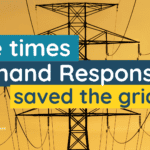The EU is seeing an unprecedented move away from fossil fuels in the form of electrification, but industrial companies aren’t finding this transition easy. European electricity prices are structurally higher and vulnerable to external influences, as we have seen with the Covid-19 pandemic and the invasion of Ukraine. In addition, many EU countries cannot currently meet the demand for connections to the grid. Industrial companies are having to adapt to this new energy landscape.
To do this, companies are making three major changes:
- Decarbonising their electricity supply
- Implementing energy-efficient programs
- Investing in on-site energy production and storage
The increase in on-site energy production and storage, combined with electrification, is contributing to a growing pool of distributed flexible resources (DFR). These are electrical devices with the potential for flexible consumption or a small-scale unit of power generation/storage that operates locally and is connected to a larger power grid at the distribution level.
The potential benefits of DFR’s can lead to greater profits and decarbonisation efforts for industrials. However, higher energy costs, unadapted grid usage pricing, and operators’ lack of knowledge can limit how DFRs are utilised. Flexibility service providers help industrials focus on maximising the value of DFR’s through demand-side flexibility.



The Role of Aggregators
Flexibility service providers like Sympower are the experts behind managing distributed flexible resources, pooling resources together and leveraging that flexibility on balancing markets to meet grid demands. This way, their customers see a return on their distributed flexible resources, without the hassle of managing them daily.
Independent flexibility services providers help industrials unlock their flexibility and link these resources to their Demand Response platform. Here they can trade industrials’ flexibility for the greatest return while helping to control resources so production isn’t affected.
The Benefits of DFRs
Accessibility
Demand-side flexibility uses companies’ resources to generate revenue. DFRs, such as e-boilers, sawmills, and combined heat and power, can be used immediately and require no upfront costs to participate in sustainable energy programs. This means that industrial companies have no barriers to entry to decarbonise their processes and unlock new revenue streams.
Generate Revenue by Providing Grid Services
Switching to DFRs can be more costly than their non-electric counterparts. However, the benefits generated from unlocking the flexibility of DFRs often make them less expensive and instantly profitable.
By selling this flexibility on balancing markets, industrial companies gain significant revenue generation, to the point that it can offset the initial difference in fuel cost of electric resources compared to fossil fuels. It is estimated that the revenue generation of DFRs represents 5-10% of the electricity costs of the resources used.
With electrification becoming the norm, using DFRs for demand-side flexibility services becomes a key enabler to shift away from fossil fuels cost-effectively.
Generate Savings with Load Shifting
Volatile energy prices have become more common due to external factors, like the energy crisis. The inherent flexibility of DFRs helps mitigate these impacts and reduce costs, two essential factors for industrial players wanting a competitive advantage
DFR’s can be strategically activated to consume more when energy prices are low, and less when energy prices are high. This enables industrials to reduce their electricity costs while keeping the same production output level.
The growing rate of electrification and decarbonisation of our energy grid is unlocking an energy future full of potential. Sympower is breaking down the barriers for industrial and commercial companies, and helping them unlock their resources’ full potential.
Do you want to learn how to monetise the full potential of your assets? Contact us today and talk to one of our energy experts.









